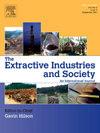Protective behaviour on artisanal gold mines: the relevance of knowledge, risk perception and access to equipment
IF 4.3
2区 社会学
Q2 ENVIRONMENTAL STUDIES
Extractive Industries and Society-An International Journal
Pub Date : 2025-05-30
DOI:10.1016/j.exis.2025.101693
引用次数: 0
Abstract
Many artisanal miners use mercury, a toxic metal, to extract gold from ore, without protecting themselves. In this study, we analyse the role of knowledge, risk perception, and improved access to protective equipment on artisanal miners’ protective behaviour. We combine survey results with a field experiment involving about 250 miners. While more than half of the miners perceive mercury as dangerous to their health, their knowledge about mercury is low despite ongoing educational programmes on the mines. Few had heard about mercury poisoning, could mention any of the critical symptoms of mercury contamination, or knew how to properly protect themselves from mercury. Risk perception was not significantly correlated to knowledge of mercury, previous training or protective behaviour. However, improving access to protective equipment by providing it for free had a large positive impact on protective behaviour one year later. Our results suggest that international policy efforts to address the mercury problem through the Minamata Convention should include access to personal protective equipment as a priority. This will have significant health benefits for miners in the short term while countries work to transition to mercury-free mining in the long term.
对手工金矿的保护行为:知识、风险认知和设备获取的相关性
许多手工矿工使用汞,一种有毒的金属,从矿石中提取黄金,而不保护自己。在本研究中,我们分析了知识,风险认知和改善获得保护设备对手工矿工保护行为的作用。我们将调查结果与涉及约250名矿工的现场实验相结合。虽然一半以上的矿工认为汞对他们的健康有害,但尽管正在开展有关矿山的教育方案,他们对汞的了解却很低。很少有人听说过汞中毒,也很少有人能提到汞污染的任何严重症状,也很少有人知道如何妥善保护自己免受汞污染。风险认知与汞知识、以前的培训或保护行为没有显著相关性。然而,通过免费提供防护装备来改善防护装备的获取,对一年后的防护行为产生了巨大的积极影响。我们的研究结果表明,通过《水俣公约》解决汞问题的国际政策努力应将获得个人防护装备作为优先事项。在各国长期努力向无汞采矿过渡的同时,这将在短期内对矿工的健康产生重大好处。
本文章由计算机程序翻译,如有差异,请以英文原文为准。
求助全文
约1分钟内获得全文
求助全文
来源期刊

Extractive Industries and Society-An International Journal
ENVIRONMENTAL STUDIES-
CiteScore
6.60
自引率
19.40%
发文量
135
 求助内容:
求助内容: 应助结果提醒方式:
应助结果提醒方式:


